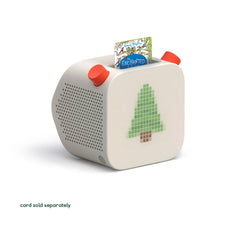The Power of Music: How Listening Enhances a Child’s Engagement with Activities
Listening to music while deeply engaging with an activity is a win-win for little ones. Our guest blogger Amelia Moore who is researching Psychological and Brain Sciences at the University of California, Santa Barbara breaks down the science on why and how music can positively impact children:

A Quick Look at Childhood Brain Development
Did you know that 90% of your child’s brain develops by the age of five? Although learning this fact can set off panic in parents, it’s also an amazing opportunity to help your little one learn and grow.
Your child’s developing brain is like a large and porous sponge filling up with water. As your child grows you’ll notice how their brain is truly absorbent; from obscure dinosaur names (Gigantoraptor anyone?) to galaxies far away, a child’s ability to retain information is impressive!
How it Works
At birth, your child’s brain hosts an abundance of cells called neurons. However, just as pores cannot function without water, neurons cannot function without communicating, and they do so via neural connections. Like water filling up a sponge, these connections are shaped by sensory experiences in a child’s environment. The young brain soaks up each new sensory experience until it is dense with neural connections!
Music and the Brain
Research shows that exposing your child to music supports their brain’s development - plus it’s fun!
Listening to music helps your baby practice processing auditory information. Your little one learns to listen for different sound characteristics. This builds neural connections that help them comprehend these sounds as music.
Later, auditory comprehension helps your child with language development. The pattern recognition, attention, and memory skills they obtain from listening to music help them learn to imitate and successfully reproduce language as they grow.
Instrumental Music Helps Concentration Last Longer
Introducing upbeat, familiar background music without lyrics during playtime can positively impact your child’s performance on nonverbal play tasks, such as building with blocks or completing puzzles. (The research that supports all this is listed at the bottom of this article!)
Why is this? The different attributes of music - tempo, tone, and layers of instruments - engage your child and invite them to keep listening, and therefore to keep pursuing their activity. Listening to happy, upbeat, and familiar music helps cultivate an environment where your child is engaged and excited to participate in the task at hand.
Try it at Home
Set up an environment where your child can listen to familiar music while engaging in nonverbal play - such as working a puzzle or a craft. Don’t forget to select something without lyrics.
An easy way to do this is to use a Yoto Player, the screen-free, interactive audio player for kids, with stimulating brain activities like the Skillmatics Piece and Play puzzle or creative activities like Foil Fun.
By allowing your child to independently choose and control the audio with the Yoto Player, you can ensure they choose music that is familiar and exciting to them. The engagement with the music will help your child feel motivated to challenge themselves to complete a Skillmatics puzzle or craft.
Our favorites for independent play
Yoto Player

The Yoto Player offers your child all the benefits of music and audio listening without any interference from screens, ads, or cameras. Children are able to select and play their audio of choice by simply placing their chosen Yoto Card in the slot at the top of the player! With a range of exciting audio options, including orchestral classics, bedtime lullabies, stories, podcasts, education, and more, the Yoto Player ensures the world of sound is safely in your child’s hands.
Piece & Play Puzzle

If puzzles came to life, they would be Skillmatics Piece & Play! A giant floor puzzle that once assembled, comes with a set of cards for two engaging search and find activities. Your child can choose to match the picture on the card to a scene in the puzzle, or for a more challenging twist, they can match a puzzle scene to the description on the back of the card. Combined with upbeat background music, Piece & Play invites concentration and focus.
Foil Fun

Watch as your little one crafts their way into a new and exciting world with Foil Fun - a mess-free, wow-worthy art kit that offers hours of creative play opportunities. With 10 picture canvases, 100+ foam stickers, 100 colorful foil sheets per set, your child can choose to enter the world of unicorns and princesses, animals, dinosaurs, or outer space, and bring their vision to life!
Yoto Adventure Jacket

Customize and protect your child’s Yoto Player with the Yoto Adventure Jacket, a silicone carry-coat that fits snugly over the Yoto Player. With a child-accessible handle that makes the Yoto Player easy to transport, and four beautiful colors to choose from, the Adventure Jacket ensures that your child’s Yoto Player is suited for a life as vibrant and exciting as theirs!
The best part about engaging your child with background music and play is that you can take this combo on-the-go! Adorn your child’s Yoto Player with an Adventure Jacket and grab a travel-friendly activity like Skillmatics Dot It and you have a play recipe that is suited for your next plane, train, or automobile experience!
Sources for research mentioned in this article
Brotherson, S. E. (2005). Understanding brain development in young children (Vol. 8). Fargo, ND: NDSU Extension Service.
Koolidge, L., & Holmes, R. M. (2018). Piecing It Together: the effect of background music on children’s puzzle assembly. Perceptual and motor skills, 125(2), 387-399.
Lebel, C., Walker, L., Leemans, A., Phillips, L., & Beaulieu, C. (2008). Microstructural maturation of the human brain from childhood to adulthood. Neuroimage, 40(3), 1044-1055.
Scott, L. K. (2004). Early childhood brain development and elementary music curricula: are they in tune?. General Music Today, 18(1), 20-27.



